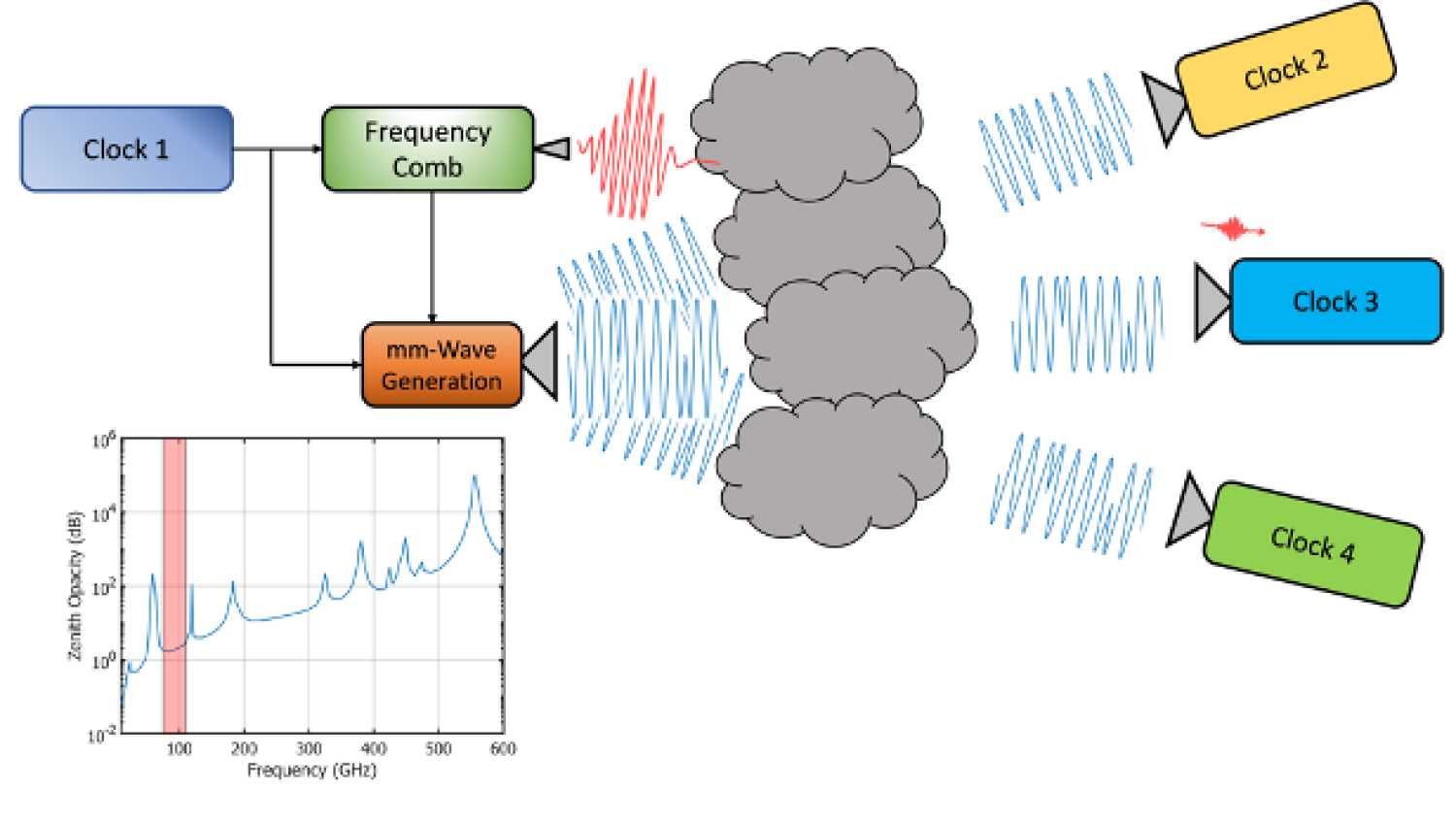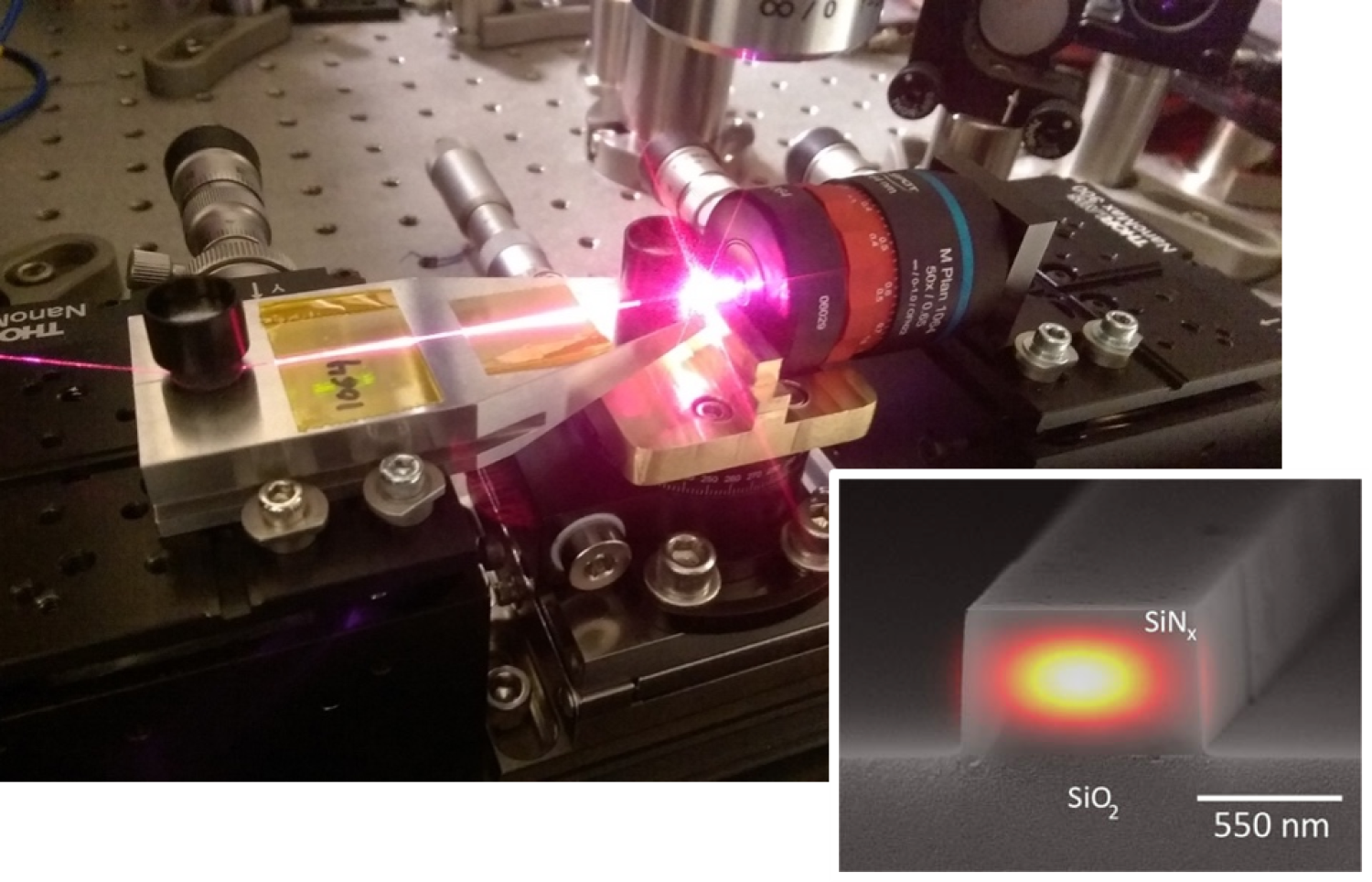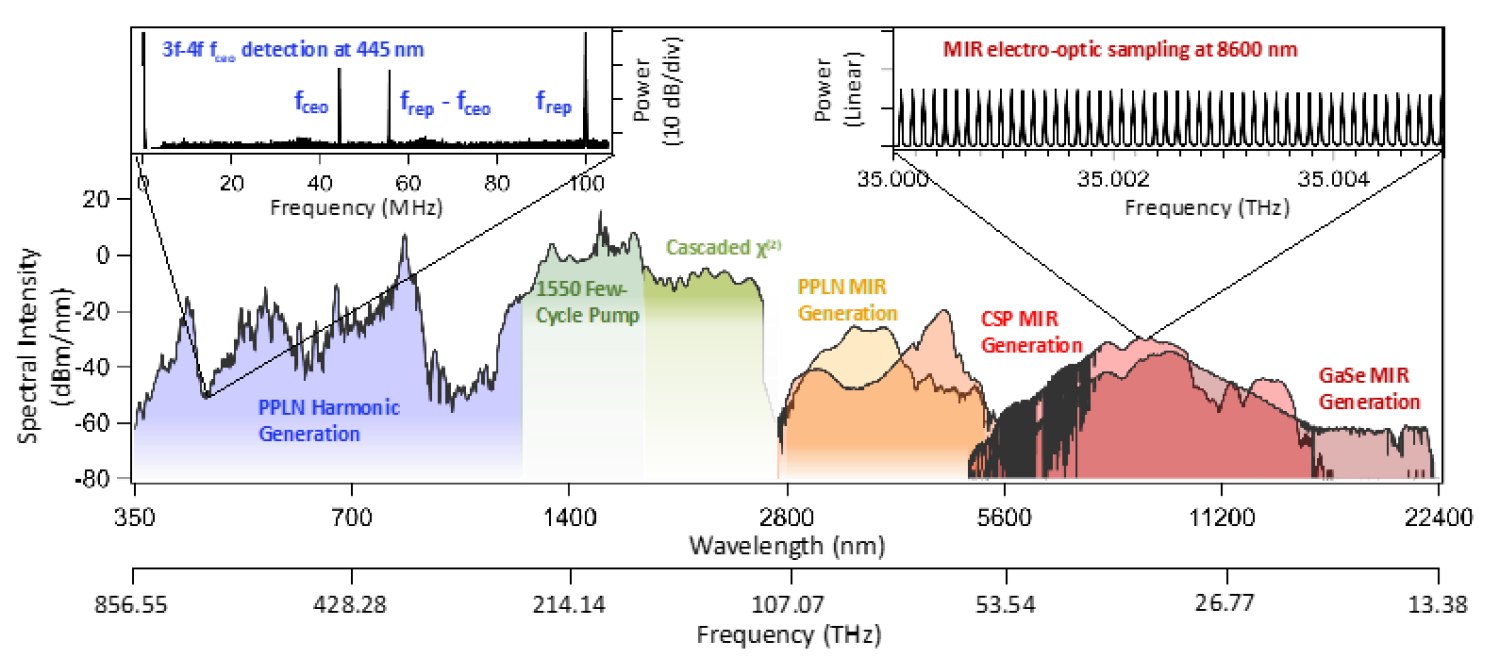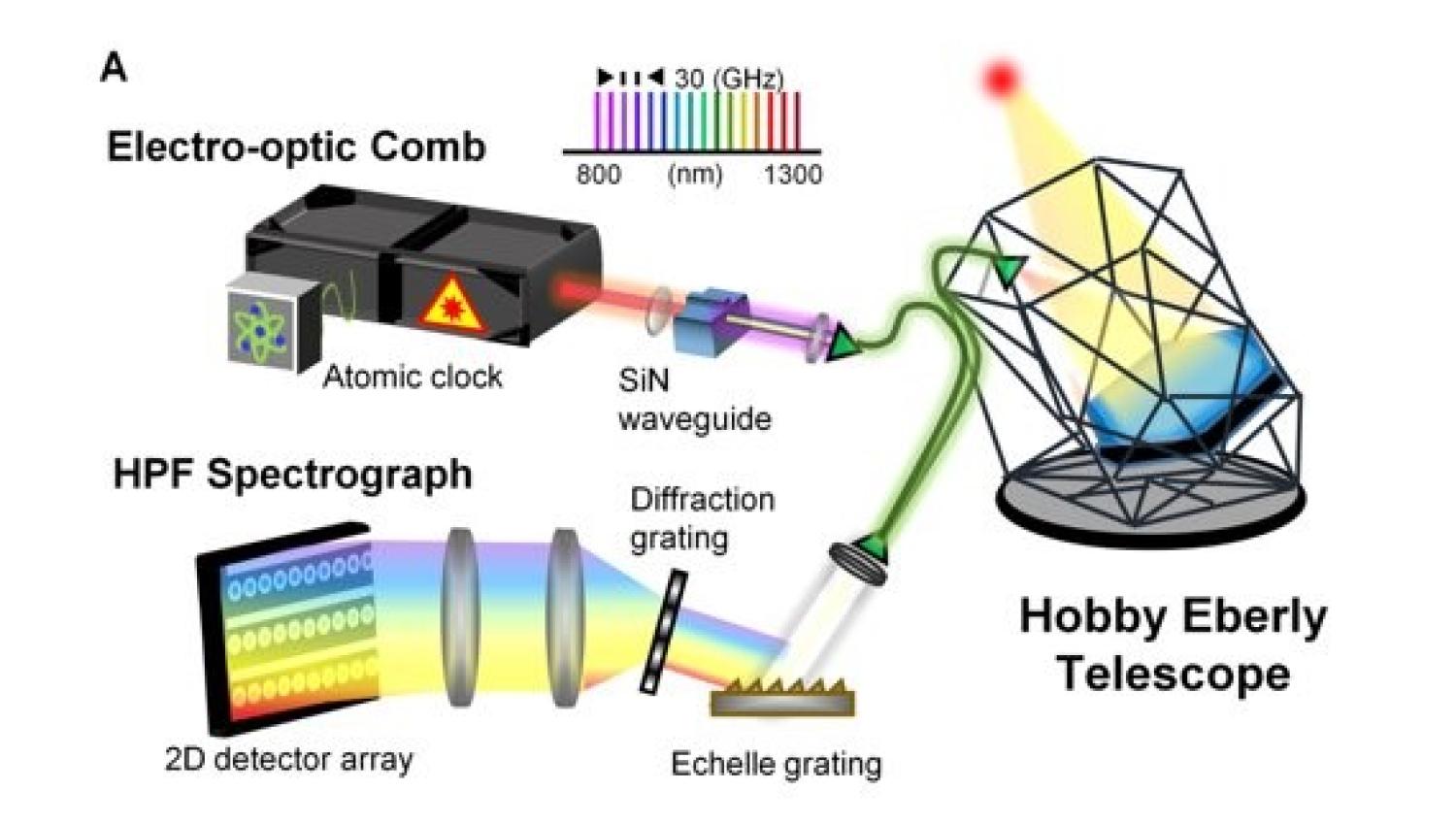Research
For nearly 25 years, the research group of Prof. Diddams has pioneered the development and use of the optical freuqency combs for the most precice measurements in spectroscopy, sensing and atomic timekeeping. Research topics we pursue include ultrafas laser science and engineering, precision timing, optical clocks, astronomy, nonlinear optics, nonlinear nano-photonics, microwave photonics, and spectroscopy from the UV to THz. In relocating from NIST to the University of Colorado in 2023, we are ramping up new experiments, while continuing much of our earlier work. Check back often as we will be updating this page to capture all the current research efforts.
Optical Clocks and Precise Timing
Optical atomic clocks keep time at the femtosecond level, which is the intrinsic timescale of light. These clocks have demonstrated frequency stability and accuracy at the 10-18 level form the basis for next-generation time standards. Our work aims to harness this precision for fundamental tests of physics, the generation of ultra-precise timing signals, and the development of optical clock technolgies for application outside the research lab.
Optical clocks
Beginning with the introduction of the frequency comb technology that enables the counting of optical cycles of light, PI Diddams and his group have advanced the development of optical clocks and clock networks. These have been used for the most accurate measurements of atomic frequency ratios and for tests of fundamental physics. A new focus is to focus on the engineering of these clock systems to make them more robust and operational beyond the research lab. We have a new project in which we will take an optical clock to the highest peaks of Colorado and compare back to a reference clock in Boulder to perform the bets test Einstein's general relativity. (more coming soon)
Low-noise microwave generation
Our group has pioneered the technique of optical frequency division and used optically-stabilized frequency combs to generate ultra-low noise microwave signals—possessing phase noise and timing jitter significantly lower than what is achievable with the best conventional electronic sources. This research involves the development of the frequency comb sources and the critical understanding of the limitations of high-speed photodetection, as well as ways to understand and circumvent the quantum limitations. (more coming soon)
Mm-wave time transfer

As part of this work, our lab continues to develop and refine techniques for optically-referenced stable mm-wave generation. These approaches are based on a combination of Er:fiber, EO and microcomb technologies.
- S. A. Diddams, J. C. Bergquist, S. R. Jefferts and C. W. Oates, “Standards of time and frequency at the outset of the 21st century,” Science, 306, 1318 (2004). https://doi.org/10.1126/science.1102330
- K. Beloy, et al., “Frequency Ratio Measurements with 18-digit Accuracy Using a Network of Optical Clocks,” Nature 591, 564 (2021). https://doi.org/10.1038/s41586-021-03253-4
Frequency Comb Technology
Electro-optic Combs
Electrooptic combs are optical frequency combs generated using the electrooptic effect. They involve modulating an optical carrier with a periodic electrical signal using electrooptic modulators. The modulated signal is then sent through a nonlinear medium which generates new frequencies in addition to the original carrier. These new frequencies form the evenly spaced spectral lines of the electrooptic comb, providing a precise and controlled series of optical frequencies. We utilize electrooptic combs for a wide variety of interesting metrology problems such as exoplanet detections, mm-wave generation, and electrooptic sampling.

- Pooja Sekhar, Connor Fredrick, David R. Carlson, Zachary Newman, Scott A. Diddams, “20 GHz fiber-integrated femtosecond pulse and supercontinuum generation with a resonant electro-optic frequency comb,” (2023). arXiv:2303.11523
- D. R. Carlson, D. Hickstein, W. Zhang, A.J. Metcalf, F. Quinlan, S. Diddams, and S. Papp, “Ultrafast electro-optic light with subcycle control, Science 361, 1358 (2018). http://doi.org/10.1126/science.aat6451
Nonlinear Nanophotonics

The impact of lasers on our world has been tremendous, as they are crucial in various fields such as manufacturing, medicine, remote sensing, and optical communications. Photonic integrated circuits have also allowed for significant advances in optical systems with applications in signal processing, data transmission, precise timekeeping, and LiDAR. Certain optical crystals exhibit strong nonlinearities that allow for the manipulation of light through second harmonic generation, four-wave mixing, spontaneous parametric down-conversion, and other nonlinear processes. By exploiting these nonlinear properties, one can tune to frequencies needed for quantum sensors and quantum metrology. Harnessing these nonlinearities on nanophotonic platforms allows for more efficient frequency conversion and lower SWaP-C. We work toward developing our own nanophotonic device recipes for novel quantum metrology.
- Tsung-Han Wu, Luis Ledezma, Connor Fredrick, Pooja Sekhar, Ryoto Sekine, Qiushi Guo, Ryan M. Briggs, Alireza Marandi, Scott A. Diddams, “Visible to Ultraviolet Frequency Comb Generation in Lithium Niobate Nanophotonic Waveguides,” (2023). https://arxiv.org/abs/2305.08006
- T. J. Kippenberg, R.L. Holzwarth and S.A. Diddams, “Microresonator based optical frequency combs,” Science 332, 555 (2011). https://doi.org/10.1126/science.1193968
Frequency Comb Spectroscopy

Spectroscopy is essential for studying molecular properties and gaining control over molecular quantum states. The development of compact frequency combs from the infrared to ultraviolet spectral regions constitutes an important step in furthering fundamental spectroscopy and atmospheric sensing. Our group works on developing infrared combs allowing for precision spectroscopic measurements addressing both vibrational and rotational states of molecules. We also have generated spectrally broad UV-visible combs through the use of high-harmonic generation and cascaded harmonic generation mechanisms in nonlinear crystals to probe the electronic states of molecules.
- D. M. B. Lesko et al., “A six-octave optical frequency comb from a scalable few-cycle erbium fibre laser”, Nature Photonics 15, 281 (2021), DOI:10.1038/s41566-021-00778-y
- Henry Timmers, Abijith Kowligy, Alex Lind, Flavio C. Cruz, Nima Nader, Myles Silfies, Gabriel Ycas, Thomas K. Allison, Peter G. Schunemann, Scott B. Papp, and Scott A. Diddams, "Molecular fingerprinting with bright, broadband infrared frequency combs," Optica 5, 727-732 (2018). https://doi.org/10.1364/OPTICA.5.000727
- A. S. Kowligy, H. Timmers, A. J. Lind, U. Elu, F. C. Cruz, P. G. Schunemann, J. Biegert, and S. A. Diddams, “Infrared electric-field sampled frequency comb spectroscopy,” Science Advances 5, eaaw8794 (2019). https://doi.org/10.1126/sciadv.aaw8794
Frequency Combs for Astronomy

The search for exoplanets around nearby stars is driven by profound scientific questions about planetary formation, evolution, diversity, and the potential for extraterrestrial life. Finding an exo-Earth remains challenging due to the required radial-velocity precision at the level of 10 cm/s. Many sources of noise, such as instrumental systematics and contamination from Earth’s atmosphere and stellar activity, complicate attempts to reach this level of precision. Improving the instrumental RV precision to disentangle the effects from these noise sources requires precise, accurate, and highly stable calibration sources. In this regard, laser frequency combs have emerged as an ideal calibration source. Our group is exploring simple and robust approaches to developing 10+ GHz astrocombs that can operate autonomously at a remote telescope site.
- A. J. Metcalf, et al., "Stellar spectroscopy in the near-infrared with a laser frequency comb," Optica 6, 233-239 (2019). https://doi.org/10.1364/OPTICA.6.000233
- D. A. Fischer, et al. “State of the Field: Extreme Precision Radial Velocities,” Publications of the Astronomical Society of the Pacific, 128, 066001 (2016) http://doi.org/10.1088/1538-3873/128/964/066001

